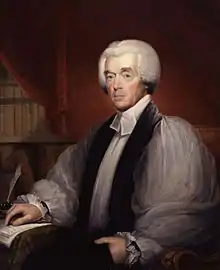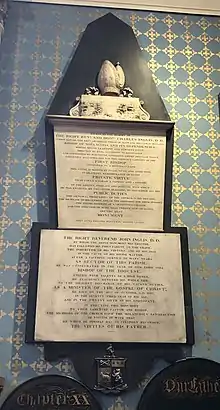Charles Inglis (bishop)
Charles Inglis (1734 – 24 February 1816) was an Irish clergyman who was consecrated the first Anglican bishop in North America, although technically of the Diocese of Nova Scotia.
Charles Inglis | |
|---|---|
| Bishop of Nova Scotia | |
 Inglis by Robert Field, National Portrait Gallery, London | |
| Church | Church of England |
| See | Nova Scotia |
| In office | 1787–1816 |
| Orders | |
| Consecration | 1787 |
| Personal details | |
| Born | 1734 Glencolmcille, County Donegal, Ireland |
| Died | 24 February 1816 |
| Previous post | Rector of Trinity Church, New York |
Early and family life
He was born in 1734, the third son of a priest, Archibald Inglis, the rector of Glencolmcille, a remote parish in southwest County Donegal, on the rugged west coast of the Irish province of Ulster.
Ministry and Involvement in the American Revolution
Inglis became rector of Killybegs, Donegal, but in 1755 he sailed to America and worked as a teacher under the auspices of the Society for the Propagation of the Gospel in Foreign Parts. In 1758 the Bishop of London ordained him as a priest. Rev. Inglis spent several years in Delaware before moving to Trinity Church in New York in 1765, where his oldest child Charles is buried.[1]
In 1776, in response to Thomas Paine's Common Sense, Inglis wrote a treatise in response entitled The True Interest of America Impartially Stated.[2]

Following the British occupation of New York in 1777, Inglis was promoted from curate to rector of Trinity Church.[3] As a Loyalist, it is recorded that Inglis prayed aloud for King George III while George Washington was in the congregation. The church was quickly surrounded by militia.[4][5] Inglis' home was plundered.[6] In November 1783, upon the evacuation of Loyalists from New York, Inglis returned to England. However, his whole congregation of Trinity Church went to Nova Scotia.[7][8]
On 11 August 1787, George III created the Diocese of Nova Scotia by Letters Patent, and named Inglis its first bishop. He preached at St. Paul's Church (Halifax).[5][9] The independence of the thirteen colonies which would form the United States had led to the creation of a new, autonomous, Anglican church there, with Samuel Seabury as the first bishop, but Inglis was the first Church of England bishop in North America, though technically his Episcopal see was "the Province of Nova Scotia".[5][9] Eager to increase the status of Anglicanism in the colonies, he supported the 1789 foundation of King's Collegiate School in Windsor, Nova Scotia, as an exclusive academy for sons of the Anglican elite. He also backed several missionary efforts to turn the majority of the population from their dissenting religious beliefs. These efforts were largely unsuccessful.
Death and legacy

Bishop Inglis died on 24 February 1816 at Kingston, Nova Scotia. He is buried in the crypt of St. Paul's Church (Halifax). His son John Inglis, also became an Anglican bishop.
There is a silver plaque in honour of Charles Inglis St Patrick's Cathedral, Dublin.[10] He became a Doctor of Divinity.
 Charles Inglis Plaque, Kingston, Nova Scotia
Charles Inglis Plaque, Kingston, Nova Scotia Charles Inglis Burial Marker, St. Paul's Church, Halifax, Nova Scotia
Charles Inglis Burial Marker, St. Paul's Church, Halifax, Nova Scotia
Notes and references
- "Sons and Daughters of Donegal" (PDF). Retrieved 3 October 2013.
- Inglis, Charles. Charles Inglis The True Interest of America Impartially Stated, In Certain Strictures, On a Pamphlet Entitled Common Sense. Philadelphia, 1776
- Hawkins 1845, p. 323.
- Hein & Shattuck 2005.
- Carrington 1963.
- Hawkins 1845, p. 337.
- Flick 1901, p. 36.
- United Empire Loyalists Centennial Committee (1885), The centennial of the settlement of Upper Canada by the United Empire Loyalists, 1784-1884; the celebrations at Adolphustown, Toronto and Niagara, with an appendix, containing a copy of the U.E. List, preserved in the Crown Lands Department at Toronto, Toronto, Ontario, p. 110
- "No. 12910". The London Gazette. 7 August 1787. p. 373.
- "Celtic crosses in St. Patrick's Cathedral". A Grave Concern. Retrieved 2015-06-22.
- Carrington, Philip (1963). The Anglican Church in Canada. Toronto: Collins.
- Hawkins, Ernest (1845). Historical notices of the missions of the Church of England in the North American colonies. London: Society for the Propagation of the Gospel in Foreign Parts (Great Britain) – via B. Fellowes.
- Flick, Alexander Clarence (1901). Loyalism in New York during the American revolution. New York: The Columbia University Press.
- Hein, David; Shattuck, Gardiner H. Jr (2005). The Episcopalians. New York: Church Publishing, Inc. ISBN 978-0-89869-497-0.
Further reading
- Cuthbertson, Brian (1988). "Charles Inglis: A Reassessment". Journal of the Canadian Church Historical Society. 30 (2): 88–101.
- Cuthbertson, Brian (1987). "The First Bishop". Halifax: Waegwoltic Press. Cite journal requires
|journal=(help) - Fingard, Judith (1972). The Anglican Design in Loyalist Nova Scotia. London: SPCK.
- Fingard, Judith (1968). "Charles Inglis and his "Primitive Bishoprick" in Nova Scotia". Canadian Historical Review. 49 (3): 247–266. doi:10.3138/CHR-049-03-03. ISSN 0008-3755. S2CID 159593439.
- Fingard, Judith (1983). "Inglis, Charles". Dictionary of Canadian Biography. University of Toronto/Université Laval. Retrieved 2015-06-22.
- Inglis, Charles (April 7, 1793), Steadfastness in religion and loyalty recommended, in a sermon preached before the legislature of His Majesty's province of Nova-Scotia : in the parish church of St. Paul at Halifax
- Inglis, Charles (January 30, 1780). "The Duty of Honouring the King". Project Canterbury. Retrieved 2015-06-22.
External links
- Inglis family and the Church
- Charles Inglis well, Clermont, Nova Scotia